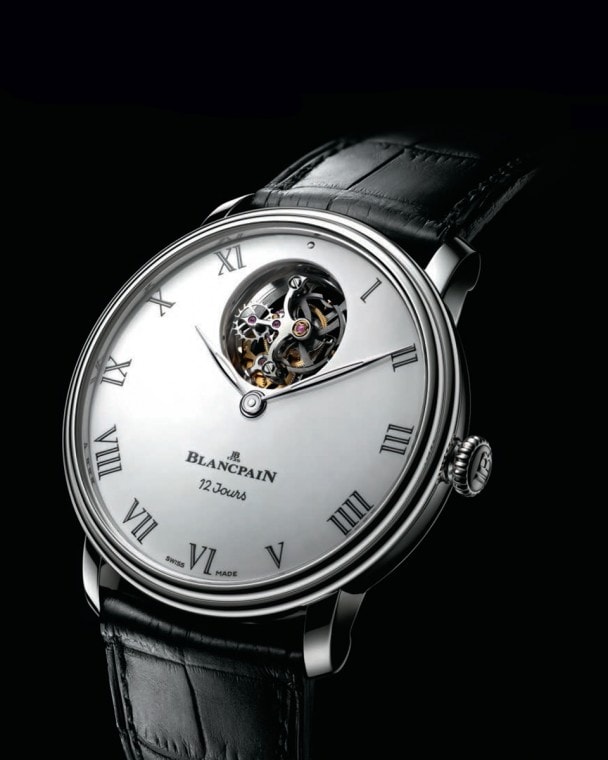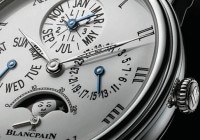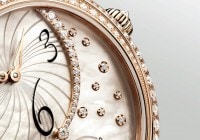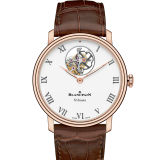
Search in Issues
Chapters
List of parts
Chapter 4
Villeret Tourbillon 12 JOURS
With a familiar look, Blancpain debuts an entirely new tourbillon.

A POWER RESERVE THAT IS UNMATCHED at 12 days.
A bit of numerology for the number twelve. No points for the association with the number of months in a year. Equally no points for either the twelve animals of the Chinese calendar or the twelve signs of the Zodiac. Twelve works of Hercules. Twelve principal divinities in Greek mythology. Maybe a bit more obscure, twelve imposing rooms in the Scandinavian paradise. Twelve lions decorating the steps of the throne of Solomon in Arab legends. Twelve planets in the solar system (a bit of fudging there as one has to count Pluto, which just lost its planet status, and then add planets thought to have been destroyed). And a twelve day power reserve for Blancpain’s new Villeret Tourbillon 12 Jours.
Before turning to a detailed examination of the Villeret Tourbillon 12 Jours and its new movement, denominated the caliber 242, it is worthwhile to pause for a brief review of tourbillon basics. The tourbillon, first invented and patented by Abraham-Louis Breguet in 1801, was conceived to improve watch chronometry. All watches are subject to small gravity induced rate errors when the watch is in a vertical position; in some vertical positions gravitational forces cause the watch to run slightly fast and in others to run slightly slow. Th e core idea of a tourbillon is to cancel out those errors by constantly rotating the rate keeping elements of the watch over 360 degrees. Th is rotation would pass the rate keeping elements of the balance wheel and escapement through both the “fast” and “slow” positions, in principle, one cancelling out the other. Classic construction, described in the first patent and followed ever since, utilizes a cage carrying the balance wheel and escapement and rotating the cage around a fi xed gear. As with all tourbillons, and in contrast with Blancpain’s Carrousel that also cancels rate errors by rotating the timekeeping components, the rotation of the cage is directly linked to the escapement. Th e power delivered by the watch’s gear train to turn the cage also powers the escapement and, if that rotation around the fixed gear were to stop for any reason, the watch would stop running
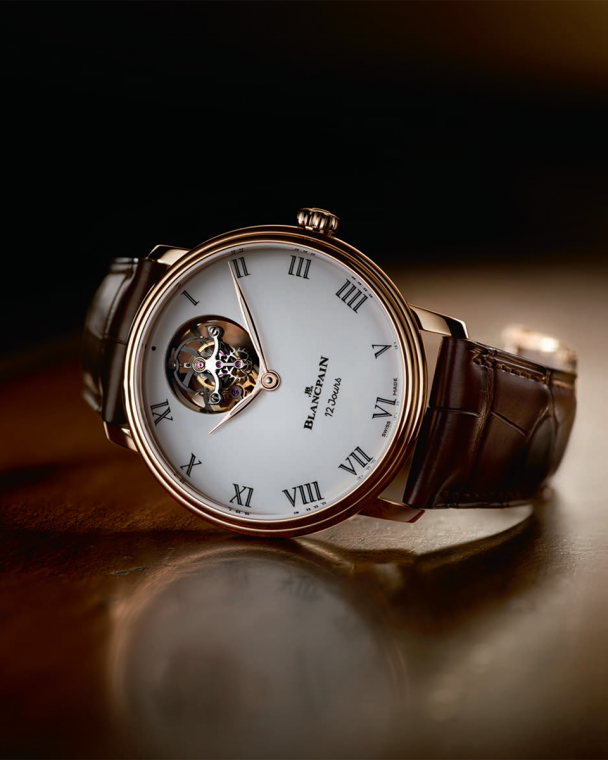
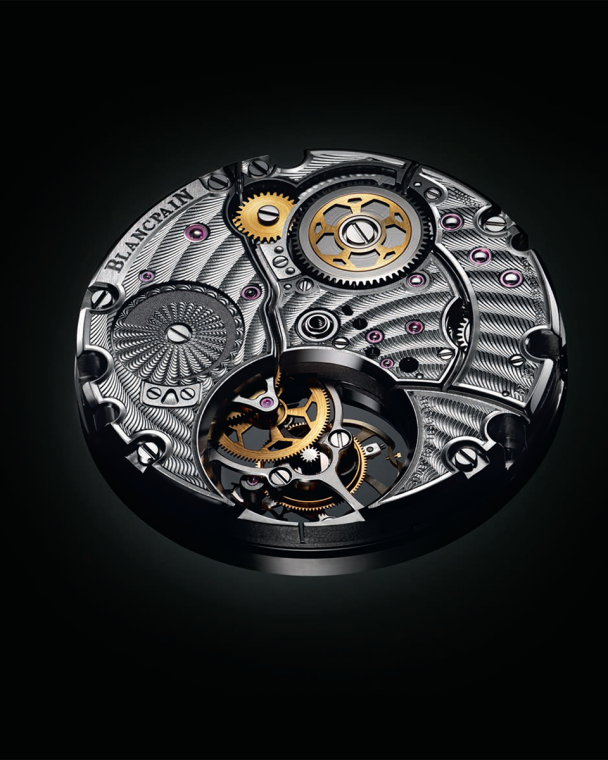
The new tourbillon offers both SUBTLE AND MAJOR IMPROVEMENTS.
No doubt there will be some Blancpain savants who, following a quick glance at the Villeret Tourbillon 12 Jours and upon spying a familiar form of tourbillon cage, may conclude that it is simply a warming over of a movement that has been in the collection for many years. That’s the trouble with quick glances, for nothing could be further from the truth. Certainly the form of the cage may honor Blancpain’s long tourbillon history, as does the off center placement of the balance wheel, but this is a 100% new movement. It was important to Marc A. Hayek from the outset of this development project that Blancpain respect tradition. The architecture of the tourbillon cage, placement of the balance wheel off center, and absence of a top bridge (which makes it a “fl ying tourbillon”, described more fully later in this article) were all watchmaking landmarks and firsts when Blancpain first introduced them in 1989. Indeed, upon its debut, it was the world’s first flying one minute tourbillon in a wristwatch and off ered the longest power reserve in history for a tourbillon, 8 days. Ironically, it has become so recognizable that Blancpain’s team has seen that when counterfeiters seek to imitate a tourbillon, the shapes they oft en use are those of this classic Blancpain design. Blancpain may have preserved this core DNA, but as we shall see, this movement, the caliber 242, is entirely new.
Before starting with a tour of all the new features and constructions of the Villeret Tourbillon 12 Jours, focus for a moment on what the eye cannot see: its performance. The name says it all. This is a tourbillon that offers a full 12 day power reserve. In fact, the watch is capable of running for around 14 days, but to be conservative is rated at 12. No other automatic winding tourbillon in the world can match this performance. What is all the more remarkable is that this record breaking capability has been achieved with a single winding barrel. Naturally, the barrel is large, both in diameter and in thickness. It occupies nearly the full height of the movement. Its winding disk (termed “rochet”) is visible from the back of the watch at the 6 o’clock position bearing a decorative wheel (with Blancpain’s signature à jante form) on its top surface.
A good place to begin the inspection of the 242 is with the balance wheel. Fashioned out of black treated Glucydur, with semi spiral shaped arms, the outer rim is curved inward at each of the four positions of the gold regulation screws. There are two important reasons for this inward curve. Since the curve is inward, the heads of the regulation screws do not protrude beyond the outer circumference of the wheel. This allows for the fitting of a larger balance wheel within the confi nes of the cage than would be the case if the reverse were true and, in fact, at 7.95 in diameter, this is the largest balance wheel of all of Blancpain’s tourbillons. There is a second important reason that underlies this distinctive balance wheel form. With the regulation screws recessed, there is less air resistance as the balance wheel oscillates back and forth, particularly as its elements pass in close proximity to the pillars of the cage. High technology serves for the spiral, as it is made of silicium.
The tourbillon cage, shaped as its ancestor, is, however, the largest that Blancpain has ever built. It’s placement of the balance wheel outside the center of rotation allows for a thinner construction than were the balance wheel centered in the cage. This placement also locates the pallet fork and escape wheel in plain view so that the “tick tock” of the watch can be easily seen as the tourbillon marches around in its rotation. In keeping with Blancpain’s traditions, the tip of the cage, which is the mounting place for the escapement, has a finger which functions as a seconds hand.
With close inspection of the tourbillon porthole one radical and four subtle differences from what Blancpain had done before will emerge. In all of its other tourbillons, the supporting bridge for the cage spans across the back of the movement. This backside support for the cage is doubly important. Standard tourbillon construction suspends the cage between two supports: one dial side, the other at the back of the movement. Blancpain achieved a very important watchmaking advance when it introduced the world’s first flying one minute tourbillon. The “flying” description means that the dial side support, generally with a bridge, was completely removed, opening the tourbillon up to an unobstructed view by the owner. Th e entire support for the tourbillon is from the back with its mounting on a back side bridge. With the caliber 242 what had been a side-to-side bridge in Blancpain’s traditional design has been replaced by a curved bridge that encircles the drive wheel engaged with the pinion that powers the rotation of the cage and, of course, the escapement. It is still a fl ying tourbillon, however, as there is no dial side bridge. With the larger tourbillon and larger cage comes a larger pinion to drive the tourbillon, a 14 tooth pinion in contrast with Blancpain’s predecessor tourbillons that use a 7 tooth pinion. Keep in mind that this pinion powers both the rotation of the cage and the escapement. This brings us to another subtle difference, the fixed gear. The basic principle of all tourbillon systems is rotation of the cage and its time keeping components (the balance wheel and escapement) around a fixed gear. The gear train of the watch delivers power to the pinion of the cage which carries the escapement that, in turn, is engaged with the fixed gear. Whereas Blancpain’s other tourbillons utilize a largely solid fixed gear, the caliber 242 has a lighter airier look with a spoked, open wheel. The final subtle distinction seen in the porthole is actually something not seen. With the other tourbillon calibers, the top edge of the watch’s hour wheel pokes up on the very bottom of the porthole; it is now fully hidden, lying behind the dial and below the hole.
The OPEN WORKED ROTOR places on full display the hand guilloched movement bridges.
One thing has not changed. The backside bearing for the flying tourbillon is constructed using ceramic ball bearings as is now done with all of Blancpain’s tourbillons. The last subtle difference that emerges from an examination of the porthole area calls upon fine powers of observation. Instead of lying below the level of the top plate of the movement, the top of the tourbillon cage extends .6 mm above the plate. In this way, the caliber 242 occupies common ground with Blancpain’s carrousels that also elevate the top of the cage above the top plate. The reason, of course, is to enhance visibility.
Time to turn the watch over. The first thing that will strike the eye of the observer is the decoration of the movement bridges which have been hand guilloched with a flinqué pattern. The winding rotor (made of red gold for the gold version and platinum for the limited platinum series) has also been hand decorated with a carved motif. However, even more eye catching is the form of the rotor. It has been open worked so as to leave open for view the decoration of the movement bridges below. There is a bit of a trick involved in order to open up the rotor in this way. Of course, taking away all of the heavy gold or platinum that would otherwise occupy the space which is now open, by itself, would reduce the mass of the rotor and adversely impact winding efficiency. The trick is that that the outside edge of the rotor extends well below its surface and outside the perimeter of the movement. That restores the mass taken away to create the open working and ensures optimal winding. There is another new twist associated with the automatic winding system. Blancpain’s other automatic tourbillons mount the winding rotor on a winding bridge which lies above the other bridges of the movement. In the Villeret Tourbillon 12 Jours, the automatic winding system is flush with the other bridges, which enhances the thinness of the watch and, as well, offers a greater surface for the hand guilloche decoration.
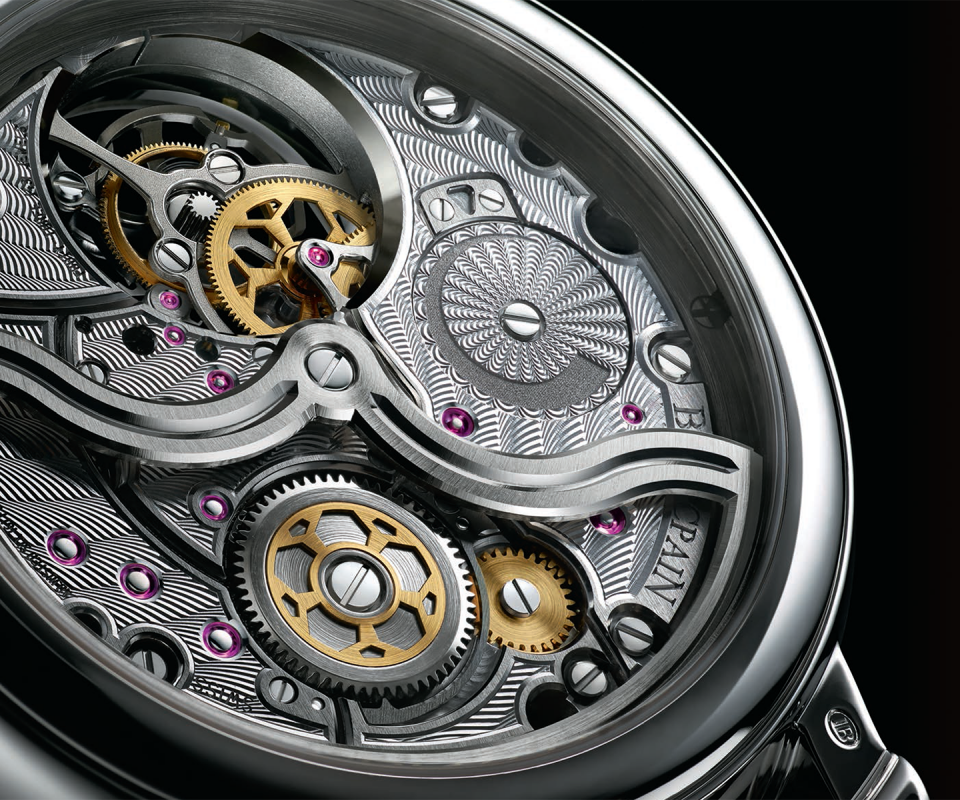
As befits a timepiece of this sophistication, the dial is fashioned in FULL FIRED ENAMEL.
With a watch that boasts a 12 day power reserve, having a power reserve indicator is extremely useful. The power reserve indication is seen on the back of the watch, with an engraved disk showing the reserve which is read from a very small bridge bearing a sculpted pointer. Locating the power reserve on the backside of the watch carries with it unassailable logic. After a moment of reflection, it becomes clear that there really are only two times when the owner would want to see the power reserve: in the morning before strapping on the watch, to be sure it is adequately wound prior to starting the day and in the evening to verify that there is enough wind to carry the watch through the period during which it won’t be worn. Either way, it is completely convenient to look at the indicator with it located on the back. Thinking further, why clutter up the dial with a power reserve indicator if it really is only important when putting on or taking off the watch? Thus, placing it on the back brings a special purity to the dial.
As befits a watch of this sophistication, the dial is in full fired enamel. Two case metals are available for this 42 mm diameter timepiece, either red gold or platinum. The platinum version is a limited edition, with a series of but 188 examples.
